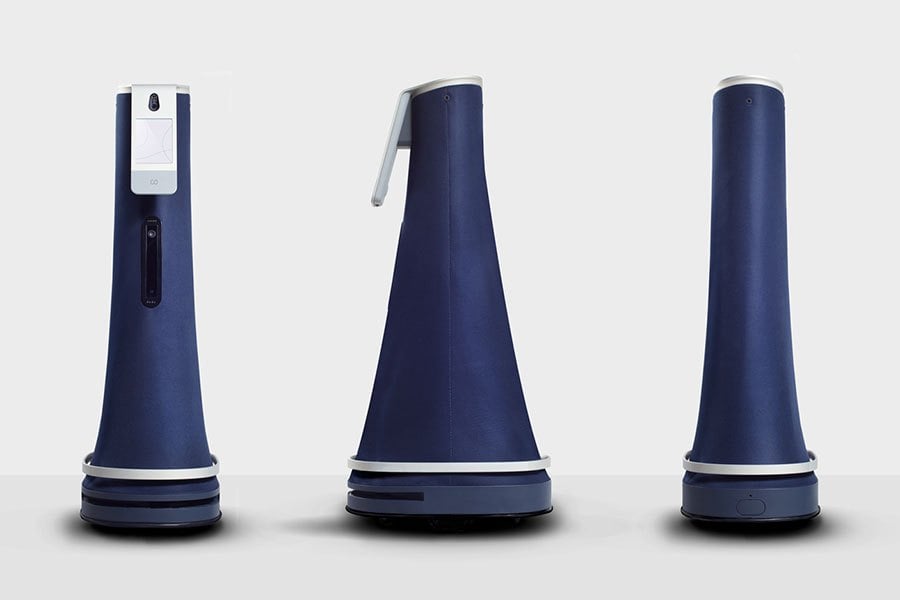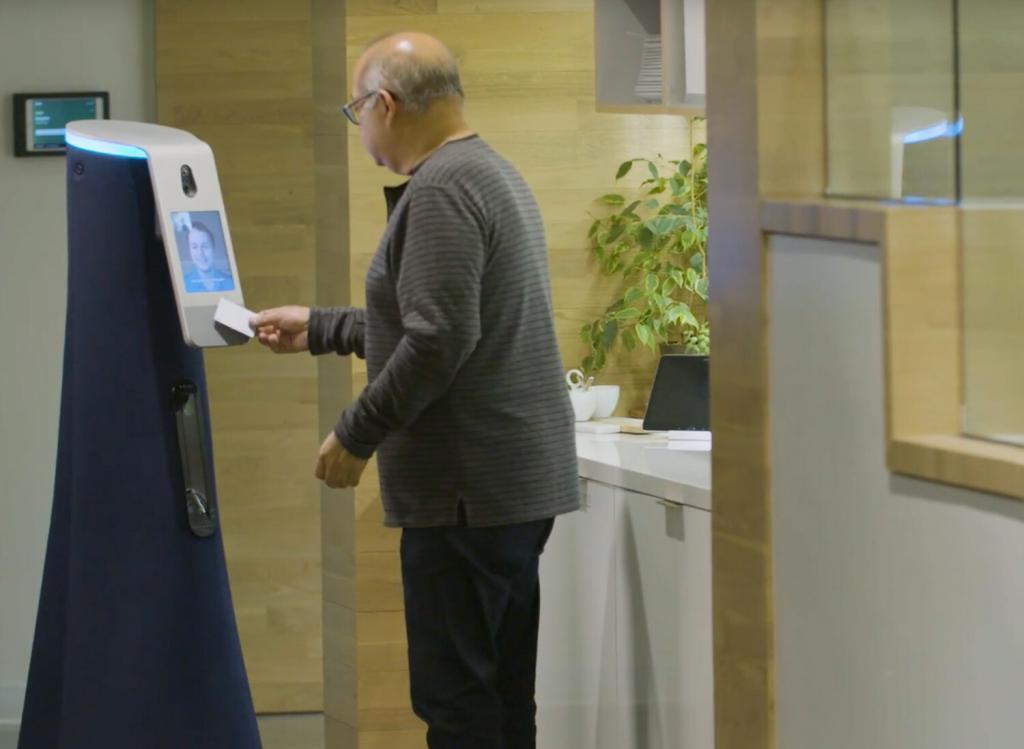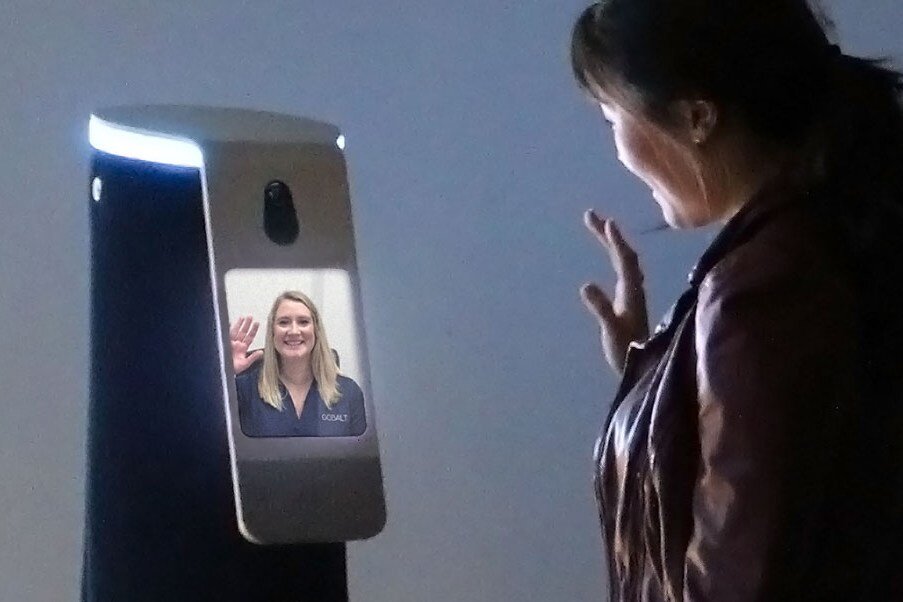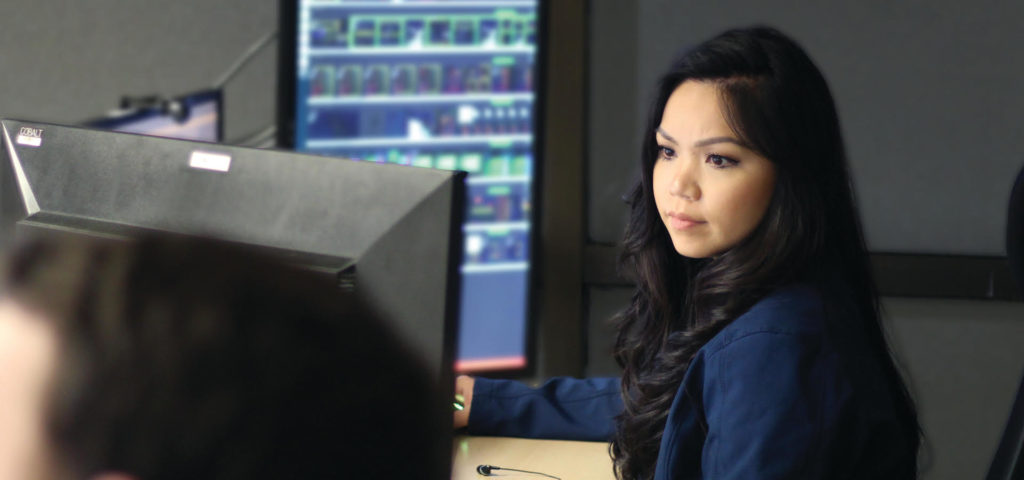The first security industry solution to allow robots to open doors Cobalt Robotics, a manufacturer...
The Age of the Robot
“The Age of the Robot” originally appeared in issue No.77 of Business Focus. You can find it here.
During the COVID-19 pandemic, we may find unlikely allies in a range of security robots.

I’m going to be honest, when you talk to me about “security robots” the first thing I think is “Daleks”. It has to be said that seeing footage of one of Cobal Robotics’ indoor security robots doesn’t immediately dismiss the idea, the way they smoothly glide across the floor definitely brings to mind the BBC baddies.
But it has to be said that Cobalt’s robots look a good deal friendlier than the sci-fi monsters, and this is no accident.
“One of our biggest concerns when starting Cobalt was cultural adoption,” explains Travis Deyle, CEO of Cobalt Robotics. “Having a five-foot-tall robot navigating through your space is a new idea; it could be very intimidating, so we spent a lot of time making sure our robots were friendly and approachable.”
Indeed, popular culture is rife with ideas for what not to do with a security robot.
“Hollywood has warped the public’s perception of robots, ” Deyle points out. “We’re not trying to build Terminator or Robocop; we are trying to build robots that are friendly & helpful, such as R2D2, Wall-E or Baymax [from Disney movie, Big Hero 6].”
For the same reason, these robots aren’t going to bark “Exterminate.” In fact your interactions with Cobalt’s robots are likely to be friendlier than a lot of encounters with human security staff.
“Cobalt’s robots are supported by remote human operators who are hired largely from customer service industries, people that are articulate, friendly & customer service oriented,” Deyle tells us. “Besides, most people that interact with the robot are authorized to be in the space, so it’s important that the robot’s demeanour is friendly, approachable and customer service-based — but easy to escalate into a security posture if need be.”
Collective Intelligence
Of course, behind the customer-facing staff, there is an elite team of security experts, providing an astounding collective knowledge base that every robot can draw from.
“Our operations team is amazing. Many of our leaders hail from elite military units, drone operations, and intelligence analysis. They’re able to train our remote operators to be on the lookout for suspicious activities & perform key data collection so that weekly & monthly reports to the clients contain meaningful insights & actionable suggestions to enhance their operations,” Deyle says. “Plus, you have the collective intelligence of your entire remote operation anywhere you have a robot. It’s not just a remote security officer — you can access your facilities director, a nurse, a doctor, language support. Cobalt offers the entire comprehensive service: robot hardware, software, maintenance and remote operators through command centres in California and Utah with 22 different languages spoken by our remote operators. It makes a profound difference having the collective intelligence of your best people on the spot.”
While Cobalt Robotics produces indoor security robots, their product offering is more in line with a comprehensive security service. The robots themselves are extremely impressive pieces of technology, backed by human experts, offered as a turn-key security solution.
“We have mobile robots that patrol around your space, building a model of what is normal and looking for anomalies: people, motions, sounds, open doors, unattended computers, unerased whiteboards, carbon monoxide levels, any number of anomalies. Sometimes the robot responds automatically, and sometimes it notifies a remote human being who can respond intelligently on the spot,” Deyle explains. “As a result, the service is very similar to what you’d get from a manned guard but with superhuman senses, perfect recall and no bias.”
New Tricks

Of course, there is still a challenge in making the case for these robots to customers, and that’s not because of Hollywood visions of the Terminator.
“If you look at the security sector comprehensively, over the last 50 years security directors have had the same three tools at their disposal: cameras, access control, and manned guards,” Deyle points out. “When it comes to cost & capability, cameras and access control are two orders of magnitude apart from manned guards, and that leaves a big gap. We provide a new colour that security directors can add to their palette to fill those gaps & create a more efficient security program. Rather than adding more fixed infrastructure, robots are mobile; they can relocate to provide on-demand coverage with more-capable sensors. At any moment, a remote person (from Cobalt or your own security team) can jump into that robot and have a two-way audiovisual interaction through the robot – something cameras just can’t do.”
However despite these advantages, for good reason, the security industry has rarely been known for being early adopters, with many companies clinging to their three, 50-year-old tools.
“Our biggest challenge is just the status quo,” Deyle admits.
Of course, recent events have seen “the status quo” turned completely on its head with the advent of the COVID-19 pandemic. However, the challenges COVID-19 presents us with are ones Cobalt Robotics is uniquely qualified to meet.
“A large number of our remote personnel are able to work from home, so operationally we adapted quickly; it really speaks to the remote nature of the service offering,” Deyle tells us. “This is exactly what the product is designed to do: Sitting from the comfort of your own home or office, you can transport yourself to Canada, the US, Australia at the click of a mouse. As premises shut down for the lockdown, many clients extended their hours of coverage or pushed for additional robots.”
But the really valuable application for Cobalt’s robots during the pandemic is turning out to be more than its ability to monitor locations remotely.
“The most profound change lies in back to work capabilities. For example, our robots have a high-resolution FLIR thermal camera,” Deyle explains. “The robot normally uses that sensor to detect people, leaks and spills and thermal anomalies, but with a simple software update, we were able to provide customers with elevated temperature screening capabilities on very short notice.”
The is only the tip of the iceberg.
“We’ve been rolling out a host of new capabilities related to ‘back to work’ activities: temperature screening, PPE checks for facemasks, and promoting social distancing. In reality, these adaptations required only slight modifications to the robot’s programming. From a manufacturing perspective, we already have the ability to detect safety glasses as part of our PPE package, so we adapted that to look for masks,” Deyle says. “Enforcing social distancing was a simple question of spatial analysis to see where people are, classifiying people too close to each other as an anomaly and saying ‘Hey, can you add a little distance between you to keep everyone safe?’.”
A Robotic Future

It’s not hard to see the demand for these applications during the current crisis, but this could also have long term consequences in terms of how used people are to seeing robots around.
“As I look broadly across service robotics, there’s a lot of interesting capabilities that are economically viable right now,” Deyle reflects. “Safety and security are obviously interesting but there’s also cleaning (especially commercial cleaning), asset tracking & inventory, and delivery. These capabilities will ultimately make companies more operationally efficient, and we’ll probably see robots providing multiple functions and converge into a common physical platform.”
Deyle is more than ready for this shift, with a PhD in healthcare robots and a passion for the limitless potential robots have waiting to be unlocked.
He tells us, “There are a lot of low-hanging uses cases right now that are economically viable, and that’s exciting. But when you think about the long-term, where you have a mobile computer that can literally reach out and touch the world – that has profound potential. Capabilities and use cases that were previously considered science fiction will become our everyday reality.”

